|
NARRATIVES

| The following pages contain detailed instructional explanations of Studio ideas, thoughts, techniques, and processes used in the construction of artwork and media products. |
| |
 |
| |
| |
| |
| TO JOURNAL |

| CONTACT
Don Bergland
redjello@shaw.ca

|
|
|
STUDIO NARRATIVES PROJECT
|
|
|
| PRODUCTION - URBAN ART - By Don Bergland |
|
| This page provides detailed Studio documentation used in the formulation of ideas concerned with the Urban Diorama. |
 |
Note - The ideas developed in this Studio project were constructed during December, 2010, while living in Puerto Vallarta and Las Ayala, on the Nayarit coast in Mexico. The Studio documentation provided below, relates how my initial interest focused on the Mexican Urban environment and the isolation/capture of certain aspects of it through photography. I discuss the idea of the diorama, background, and set, and then the objects or figures which occupy the set. At first, I do this with the real environment and photography. Little by little, I start moving these ideas into the digital Studio, replacing the real world with 3D constructed models in software programs. Finally, I give up my attempts to work in the real world and devoted my Studio effort inside digital software. |
| SUNDAY, DECEMBER 12, 2010 |
| |
| I set out on this trip with a number of objectives: |
| FINE ART |
|
ETHNOGRAPHY |
| I want to collect photographs to use in my Fine Art work, such as dioramas, urban statements, etc. These would be processed as "paintings" and the final products would be sent out to exhibitions. |
|
I also want to write about the Mexican urban visual landscape (environment). These images would support statements I want to make in various journal, blog, and book writings. The final products would be illustrations that support text writing. |
| Dioramas - My plan for this is to spend time collecting dioramic objects in Puerto Vallarta and other towns, and take them with me to Los Ayala. In the spare room we have there, I would set up some dioramic situations and photograph them. |
|
Dioramas - For writings about dioramic construction, I would take illustrative photographs of my journeys around Puerto Vallarta and other cities and towns searching for appropriate objects. I would also document how I set up the dioramas and did the photography. |
| Found Images - I want to continue my 15-year involvment with this type of imagery (close-up photographs of urban shape and texture). |
|
Found Images - This concept again focuses on collecting documentary images illustrating the process of hunting down and collecting the Found Image. |
| Urban Environment - I want to set back from the closeness of the Found Image and start to make some social/cultural statements about urban aesthetics in Mexico. |
|
Urban Environment - So, I guess the alliance continues. If I am going to take images of this nature, I also want to document my adventure through this type of thinking. |
|
| I'm not sure there is a huge difference in distinction between these two terms. Any photograph could be used "ethnographically," but I suppose only some could be used for "fine art" purposes. |
| The interesting thing at the moment is that both these directions use "photography" as the main image construction tool. When I have been in Mexico before, the camera has always been my main instrument for image collection. In the past, I have collected thousands of photographs as "Found Images." |
| (Sidebar - "Found Image" is my term for the kind of image I have collected in Mexico since I started my annual journeys here in 1995, I have threatened to write an article about this concept for over a decade, but so far, this threat has remained invalid. |
| The camera and my very limited photographic skills have been adequate for the collection of this kind of material in the past. But now, moving up in terms of Fine Art and Ethnographic image collection is a little daunting. Aside from aiming, composing, and clicking, I really know nothing at all about the technical processes of photography. I know absolutely nothing about lenses, lighting, and how to obtain good results from the camera in one's possession. "Found Art" photography has simply involved close-up interactions with a set of near abstract textures and shapes. It hasn't required me to think about the camera in any other way than as a collector of this flat image set. But in stepping back and wanting to capture a larger scenic environment, I am confronted with my ignorance! I definitely know what I want in terms of composition. I'm not sure I will be able to exploit all the features of a camera in order to bring about the best image. Of course, I do have the Photoshop skills to reconstruct any photographic image the way I want. Maybe this is the way I'll have to think about my introduction to this aspect of my studio direction. Collect the best photographic image I can and then rebuild it to more exacting specifications in Photoshop. |
| I brought 2 cameras down with me. My small Canon Powershot SD780 IS and an older SLR Canon Rebel EOS. |
 |
| I want to do some comparison photography to see which one works best for the kind of images I want. I suppose I'll have to take them both along with me today and spend some time taking dual shots of the same event. |
The other thing to think about is the focus of the photography. Earlier today, I thought of a few categories:
- Dioramas
- Found Images
- Urban Environment |
| Maybe there is a way to combine Dioramas and Urban Environment |
| For example, set up the dioramas in an urban setting. Find an interesting setting, with good natural light (and ability to cast shadows). Focus on a ground/wall situation where both contain some interest. This could be called "Authentic Mexican Urban Dioramas." |
| 1. |
Collect some interesting diorama objects |
| 2. |
Design some collection sets (arrangements, compositions) |
| 3. |
Practise setting these up and taking them down |
| 4. |
Pack all these objects into a travel bag. |
| 5. |
Take the travel bag and camera out into the city. |
| 6. |
Find an interesting outdoor urban setting with the following specifications |
| |
|
- good natural light (with ability to cast shadows) |
| |
|
- wall - interesting background texture |
| |
|
- ground - interesting tiles, textures, paint, etc. |
| 7. |
When a spot is located, quickly set up one of the dioramic compositions. |
| 8. |
Photograph the composed diorama. |
| 9. |
Take it down, head for another location and repeat from #7. |
| 10. |
Have another person as a second photographer, photographing people who would stop to watch the original dioramic photgraphs being taken, i.e., treat the setting up of the urban diorama as a performance event. |
|
| So, an interesting day venture into town could be to identify some diorama settings. But I need some diorama objects in order to make this happen. We are only in PV until Thursday. |
| But, I could wander about the city a bit and take some draft photos of potential dioramic backgrounds, just to see if this is a possibility. |
| 4:30 am - Went down into the city to try and collect some diorama (dioramic) backgrounds. I collected quite a few. Unfortunately, the sun had set somewhat so the lighting was rather flat. No shadows, or shadowed places. |
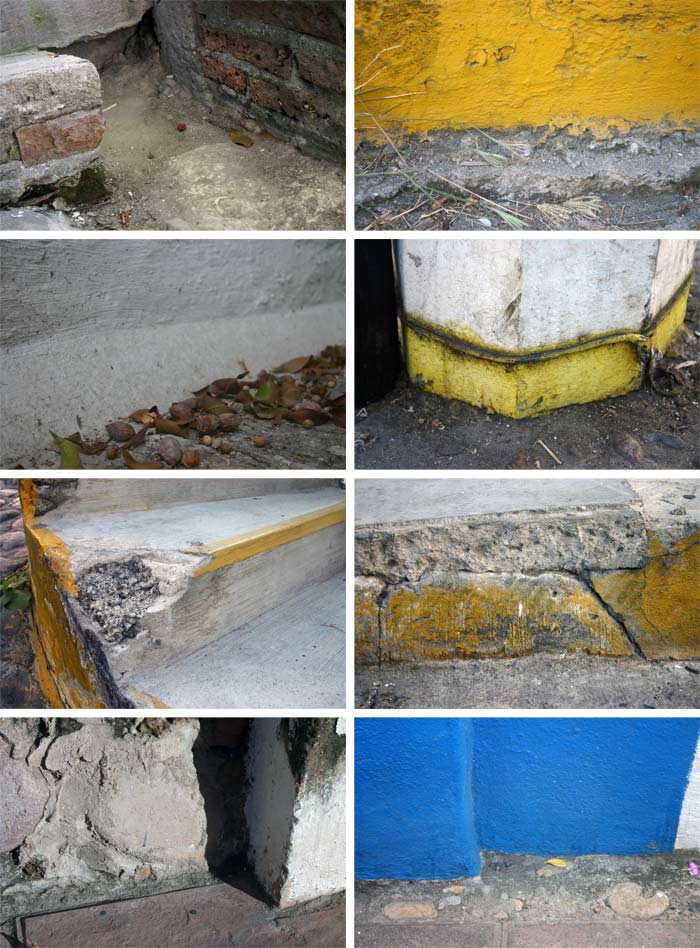 |
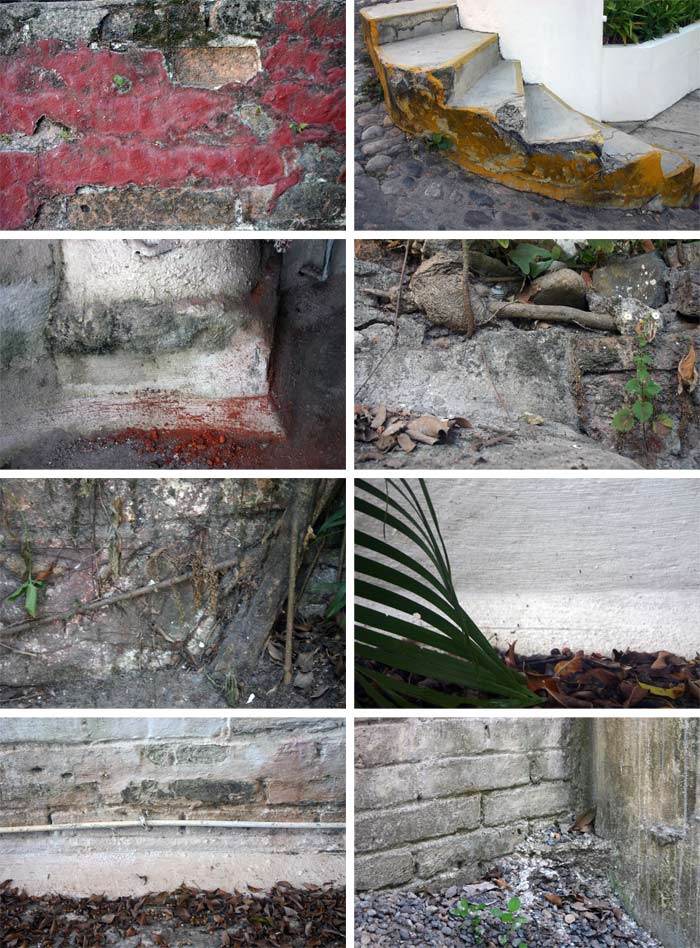 |
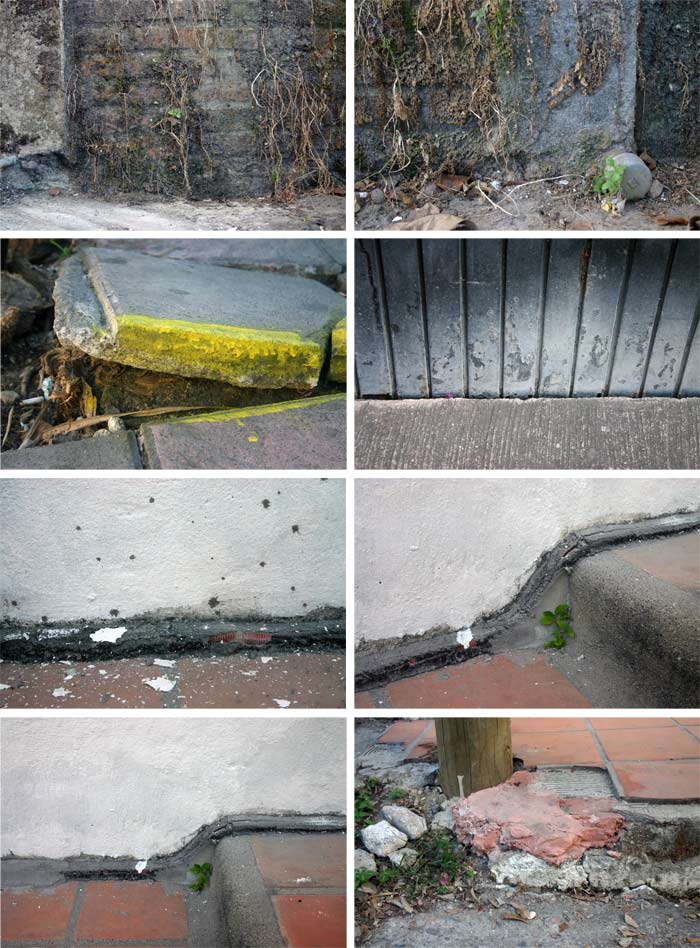 |
| As I was taking these, I thought of another method. The foreground objects could be photographed separately, then composited into the backgrounds. |
| Another method - diorama backgrounds themselves constructed separately, out of different texture components, i.e., back, ground, and sides all put together out of constructed material. In fact, all components could be composited together. |
| |
|
| |
|
| |
|
| |
|
| |
|
| |
|
| |
|
| MONDAY, DECEMBER 13, 2010 |
| |
| While taking background photographs yesterday, I realized that there was a very physical aspect to the collection of the images. Most of the good dioramic images are at ground level, where the ground meets a wall. |
In seeking out urban dioramic background settings, there are two immediate areas of interest:
1. Wall/Sidewalk
2. Curb |
| The requisites in a site is a horizontal area where objects can sit, and a vertical backing against which they can be profiled. |
| The Wall/Sidewalk site involves the area where the wall of a building meets the sidewalk. |
| In Mexico, these can be very interesting. The colors, textures, peeling paint, and crumbling masonry all offer incredible visual experiences. Just looking "down" as you stroll a Mexican street is an incredible visual experience (Note - the following images were gathered in Tequila in January, 2010). |
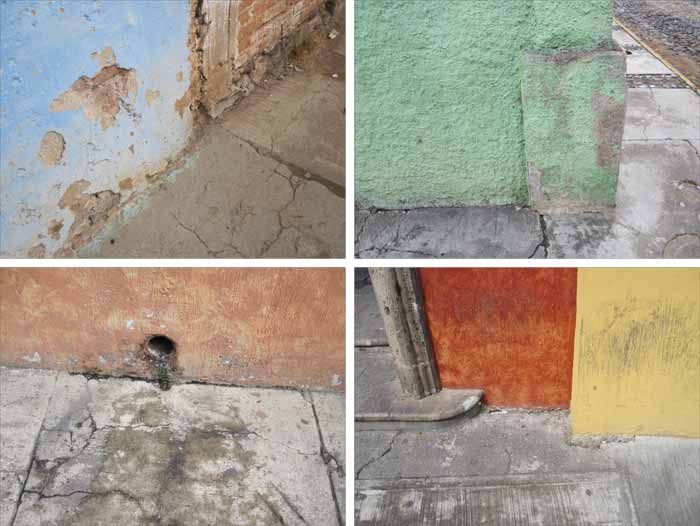 |
| The Curb site involves the area where the road meets the rise of the curb (note, the first image was gathered in Tequila, the following 3 images were gathered in Puerto Vallarta in 2010 - this trip). |
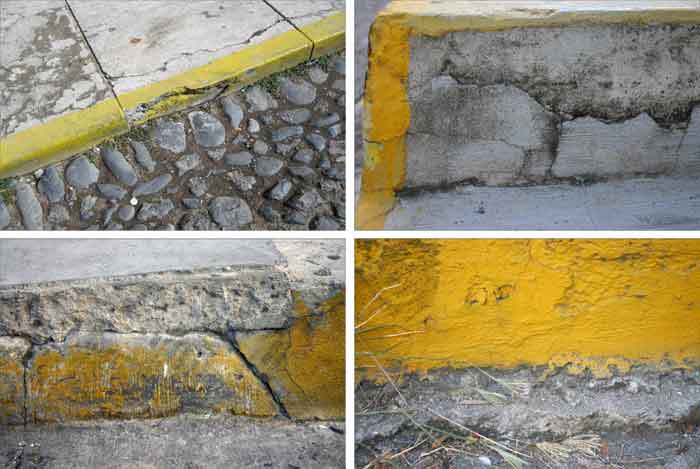 |
| Curbs are not usually as colorful or varied as the Wall/Sidewalk sites, but they do have an interesting assortment of textures. In Mexico, most of these will contain "curb yellow" as a part of the image. |
| Each of these two areas offers an immediate setting consisting of horizontal and vertical planes. The position of the camera when capturing a discovered setting is very important. If the shooter stands while capturing the image, the result is the standard "shoulder shot," something which looks fairly contrived, as if the viewer is looking down on the setting. |
 |
| The standing shot is the easiest to get, especially if one is in a crowded urban setting. The better and more natural photograph of the setting, however, comes when the shooter bends down, to lower the camera to a better position. Viewers of this image feel more like they are actually "in" the setting, rather than "looking down" into the setting. |
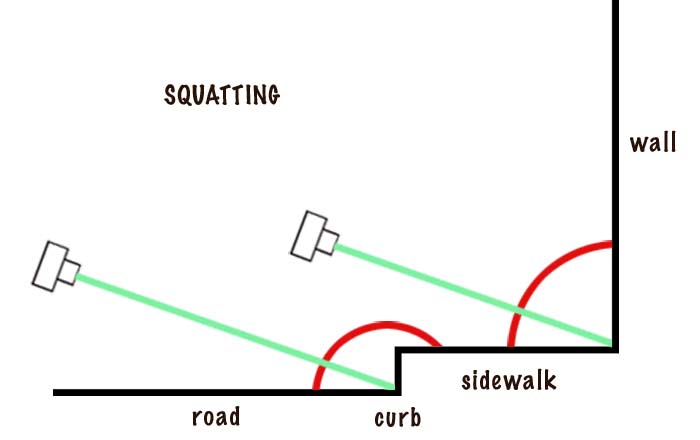 |
| This usually means a full squat and the physical ability to accomplish this. I remember my early days in Puerto Vallarta (a dozen years ago) when I was using this technique to gather what I called the "Found Image." I was easily able to get amazing close-up shots of crumbling textures, peeling paint, and cracked pavement because my body was able to bend, squat, kneel, sit, with speed and reliability. Now, a dozen years later, I find that I am a little out of shape. Getting those amazing close-up shots is a little more difficult. |
| So, I've begun a program of sit-ups and other physical exercises to see if I can regain this physical mobility. The other alternative is to kneel on one knee. In Puerto Vallarta, this is not a palatable option as the pavement can be very punishing. If I decide to use this technique, I'll have to bring something to kneel on. |
| There is also another site area I didn't mention. This is the set of stairs. These can contain very interesting tile patterns and textures as well as an assortment of colors and fragmentation. |
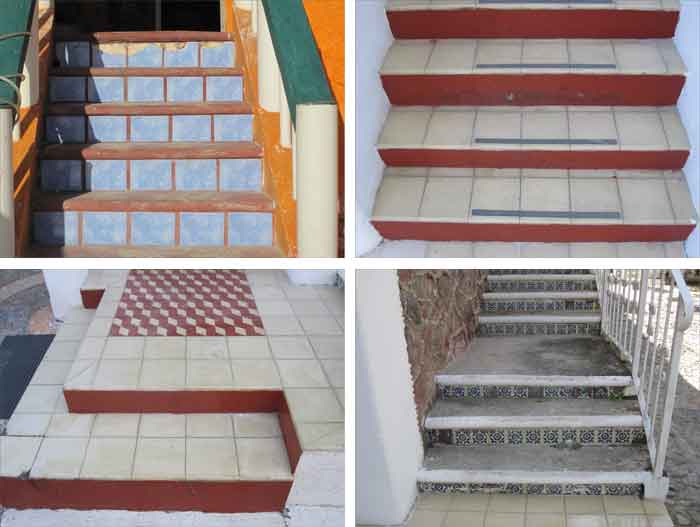 |
| When using stairs as a site, you have to move in very close as the ground and wall events are quite small. The interesting thing about stairs as a site is that you can usuallly "stand" and take a shot higher up on the stairs, avoiding the squatting issue discussed above. |
As I discussed yesterday, there seems to be a variety of different ways this type of dioramic activity can occur:
1. Real setting, real objects - a photograph
2. Real setting, compiled objects - a digital image
3. Compositied settings, composited objects - a digital image |
As I reviewed the background images I took yesterday, I thought of one setting that hosted a collection of bones, a small skeleton. This could be realized in a number of different ways.
1. Real/Real - Acquire a set of bones, find a real setting, compose the image, photograph.
2. Real/Compiled - Acquire a digital set of bones, bring home a captured setting, compose, digital image
3. Composited/Composited - Digital bones, digital images, compositing, digital image |
| I'm going to try one exercise with a setting I gathered yesterday. This will involve finding a digital object and compiling it into a real setting. As an object, I am thinking of the skeleton of a small animal. The ideal procedure for this would be to set up the object in a 3D modeling program, the use a rendering. |
| Them Bones - Daz - 19.95 |
| All I am interested in is trying the Real/Composited variation of the dioramic composition. I shouldn't get hung up on what the foreground object should be. Maybe the best thing would simply be to open the captured background in Photoshop and then improvise. A kind of jazz improvisation based on what the setting provides as musical structure. |
| 8:55 AM - Maybe the best thing to do, if one is working on the Real/Composited version, is to actually collect photographs of foreground objects as well. The way I've named this concept isn't really accurate. Both aspects of the image (background/foreground) are in fact real, they've just been photographed and the composite takes place in the digital studio. |
| So, maybe today, I focus on collecting photographs of foreground objects. I should probably design a standard POV and make sure I take all my shots from this (both foreground and background). |
| For now, however, I just want to explore some compositing exercises, so I'll use some digital foreground objects. I'll search some of the online photo sites. |
| I played around with some compositing examples for a while but nothing effective resulted. I think I could end up spending a lot of time trying to composite things together and not come up with anything that met my expectations. |
So, the most effective way I can use my time is by going back to the original idea:
1. Find Objects
2. Find Settings
3. Compose the Objects in the Settings
4. Photograph
5. Post-Process |
| So, I'm going to go and look for stuff. On our first night here, I saw some papier-mache dolls in the window of a store. They were quite surrealistic looking and didn't have too much of a mass-market look. I'm going to see if I can find that store again. |
| We only have a few days here. So, if I want to use Puerto Vallarta settings, I'll have to get some objects quickly. For two weeks, we'll be in the Guayabitos/Los Ayala/La Pinata area. But there might be good settings there also. |
8:30 PM - I'm in the process of constructing an artform. The specifics of this artform are not particularly original or new, but they are unique to me in that they are emerging out of previous work I have done and finding shape in my immediate interests and aesthetic directions. My previous work has focused on the production of "technosurrealistic" digital paintings. These paintings were constructed by composing modeled objects within virtual environments. The final arrangement of objects and settings were rendered (photographed), processed, and then exhibited as digital paintings. The studio pipeline for this style consisted of five basic steps:
1. Acquisition of modelled objects
2. Construction of a theatrical setting
3. Composition of the objects within the setting
4. Use of a camera to take a final image of the set
5. Post-processing of the image (photograph) as a final artwork
Over a hundred paintings were produced using this pipeline and most of them were shown in international exhibitions. Thousands of hours were spent in the virtual studio, finding appropriate objects and arranging them in specific theatrical settings. For me, these five steps comprise the central aesthetic process in my creative expression and, as a result, they are ones I seek to retain as I attempt to express myself through a different kind of studio action. |
| What seems to be emerging so far, is what I have initially termed, Urban Dioramas. This is not really a good name, however. This defines the place where the backgrounds are selected, but does not refer to the method. The method, involving real objects set up in real settings, then photographed, is the key thing to define in the title. An element of this is the performance, although this is an added feature, not particularly necessary. |
| I am not sure, however, that this particular artform, as it has evolved over the last few days, is really "diorama" any more. |
Diorama - Greek - dia (through) orama (that which is seen, a sight), panorama.
I wonder if this is diorama as much as it is theatrical staging, or some other kind of event. If the objects used in the work are life-size and the settings real, what is it? |
- diorama
- theatre
- staging
- installation |
| I think the term "installation" or "sculpture in situ" better describes the event (I'm not sure about "sculpture") |
| Note - I found a website which describes the following as "art urban installation." |
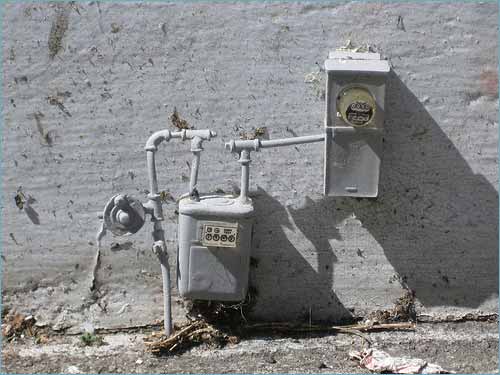 |
| Definition of installation - "art that is created for a specific site, often incorporating materials or physical features of the site." |
| So, here is some more word thought - If I set up an arrangement of objects inside of a setting that I constructed, would I call this "diorama?" If I set up an arrangement of objects on a city curb, would I call this "installation?" |
Anyway, some of the components of this artform:
- objects
- urban settings
- composition
- photography
- performance |
| There are actually two phases to the composition. The composition of the objects outside the setting (getting ready), and then the final composition within the setting (for the photograph). |
Some considerations are:
- pre-arranged settings
- improvisational settings
- pre-arranged compositions
- improvisational compositions
- dioramas constructed, photographed, and then immediately deconstructed.
- the same object composition can be rebuilt in another setting |
| Urban Installations |
| 1. |
Objects |
| 2. |
Site |
| 3. |
Composition of Objects within the Site |
| 4. |
Photography |
| 5. |
Post-Processing of Photography |
|
| These are the identical five steps I have been using in my virtual paintings. |
| If one is going to be in a city for a long period of time, then certain sites can be documented and objects collected specifically for a site. If one is passing through a city, then a more improvisational approach must be used. |
| I have talked and theorized enough about this application of methodology to practise. Now it is time to actually start putting together a collection of object and hitting the field for some compositional work. |
|
| TUESDAY, DECEMBER 14, 2013 |
| |
| Although I am trying to make this Mexican studio experience focus on actual physical work, I'm wondering if I should also continue to engage in the virtual dioramic studio. Maybe I should see if I could actually reconstruct a natural background inside the virtual studio. This might be an interesting morning exercise. |
| So, I'll start a project folder - bergland/studio archive/art-visual/artwork/digital/1174-Urban. |
| I'll select a photograph to try and reconstruct. |
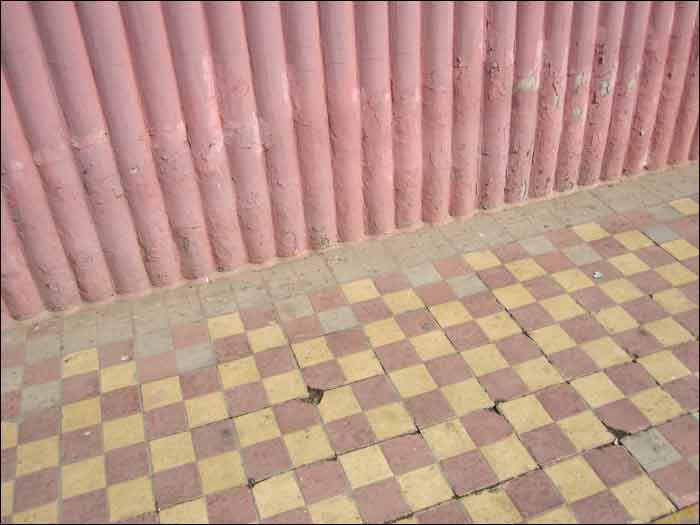 |
| This image was taken in Tequila/Jan/2010. I'm going to try and reconstruct this digitally (in a 3D dioramic form) |
| To do this, I need two complete texture maps. The back wall pattern and the sidewalk tile pattern. The pattens in these need to be perfectly straight and regular. |
| The first thing I need to do is to reconstruct the street as a separate file, then reconstruct the wall as a separate file. I'll then map these to two primitives in the Poser environment. |
| Open the photo in Photoshop and start reconstructing the sidewalk. |
| 1. |
Duplicated the background |
| 2. |
Filled old background with white |
| 3. |
Split the image into its two parts (back, front) |
| |
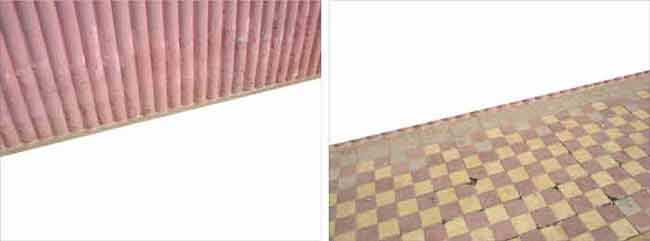 |
| 4. |
Start with back wall. First straighten the corrugated lines (Transform - Distort). Then expand the image by duplicating it, moving the duplicated layer up, merging the layers, and using the Clone Tool to integrate the lines. |
| |
 |
| 5. |
Now I'll do the same with the sidewalk (ground). First straighten the checkered tiles(Transform - Distort). Then expand the image by duplicating it, moving the duplicated layer up, merging the layers, and using the Cut/Paste and Clone Tool to integrate the tiles. |
| |
 |
| 6. |
I now have two organized texture maps from the original image. |
| |
 |
| 7. |
I'll name these maps - corrugated01.jpg and tile01.jpg |
| 8. |
I'll install these maps in the Runtime folder in Poser. I'll create a new folder in Don Textures called Mexico and store them there. (Note - I'll have to remember to bring this folder back to my main studio Runtime folder when back home). |
| 9. |
I'll launch Poser. For this computer, I'll reduce the preview window from 1500 x 1000 to 1000 x 667. I'll save this file as site01. |
| 10. |
I'll construct a wall and ground from 2 primitives. I'll then map the wall and ground with the two images I reconstructed. |
| |
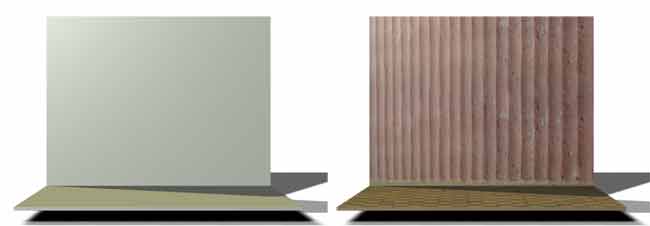 |
| 11. |
I'll do some camera work, first setting the focal length at 25%, then at 50% |
| |
 |
| 12. |
Interesting reconstruction, but there are some things that maybe need improvement. The tile size versus the corrugation size. Should the corrugation be smaller? |
| 13. |
I suppose the only way to really test this would be to place the original and the model side by side. |
| 14. |
I changed the lighting (EerieAsylumCell/LS00Neutral) and positioned the model to be similar to the original. The original image is in a different proportion than the model I made, so there will be a difference. I also didn't spend much time looking for a good lighting system. |
| 15. |
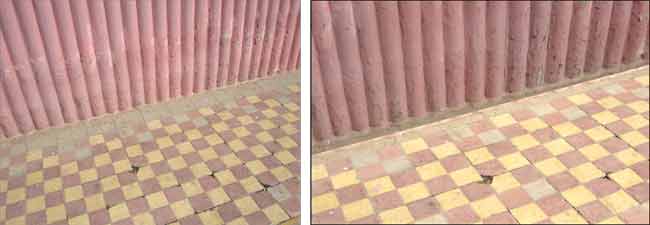 |
| |
The one on the left is the original photograph. The one on the right is the digital 3D model reconstruction. |
| 16. |
So, this is what the end model looks like as the dioramic form. |
| |
 |
|
| 8:50 am - So, I spent two hours this morning reconstructing a Tequila Found Image. Although I did this quickly, itwas a good exercise. It shows that digital reconstructions of Mexican streets can occur. |
| But - This was a very simple construction using only a flat wall and flat street surface. Mexican streets are rarely this simple. They consist of some very elaborate modeling, sections, blocks, things jutting out, etc. |
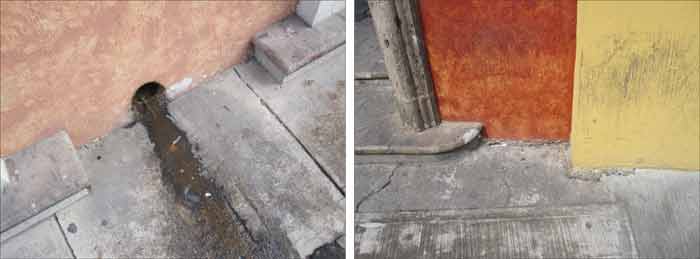 |
| In order to construct Mexican street sites with some authenticity, I would have to have a set of "abutment" models that could be brought in and appropriately textured. I would also have to make sure I had door, corner, and other kinds of models that replicate the complexity of Mexican streets. |
| My next studio exercise should be to attempt a more complex street scene or add some objects to the current model. |
| This exercise also provides another interesting project idea.This new project idea is to build texture maps of street/wall sets. These could be saved as a Resource Set and used (as image generators or lesson projects) or marketed. |
So, in my journeys through Mexican environments in the next few weeks:
- Found Images
- Texture Images
- Urban Installation
- Urban Scenes |
My seeming inability to get physical objects together for the installation process has brought my attention back to the digital studio. I have been thinking of doing some digital work with the virtual site I designed this morning. To develop some images, I need some 3D objects that have a Mexican style:
- Dolls - Content Paradise - 6.00
- Toy Store - Renderosity - 12.95
- Toy Objects - Content Paradise - 4.50
- Die Cast Toys - ShareCG
- Top - ShareCG
- Toy Block Set - ShareCG
- Grab Back of Objects - ShareCG
- Abnormal Primitives - ShareCG
- Toy Blocks A-Z - ShareCG
- Lab - ShareCG
- Ancient Offerings - Daz3D - 14.95 - Broken vases, etc. |
| After some searching, I was unable to find any 3D models related specifically to Mexico. |
| But, I probably have enough to play around with in my current inventory - Standing Mirror, Stuff from the basement models, debris, dress form. Also - the destroyed, or deteriorated bike. newspaper, etc. |
| I should just start a modeled set and see what happens. I'm not so much interested in making an actual product as I am in seeing how I can make this kind of a set work as effectively as a real installation. |
| So, I'll start a project folder - bergland/studio archive/art-visual/artwork/digital/1175-UrbanStillLife. |
| 1. |
Duplicated "site01" in folder #1174 to folder 1175 as "site01." |
| 2. |
Launched the site01 file. |
| 3. |
Installed Pebbles, Cardboard Box, Canpaint (Scary Basement), Old Iron, Cycle Wheel (Props Scarier Basement) |
| 4. |
Arranged the objects in some kind of compositional order. |
| |
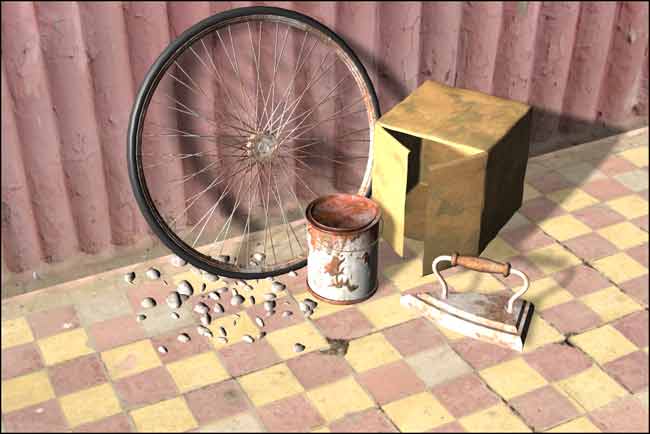 |
| 5. |
Rendered it to produce a quick exploration of set building in a Mexican environment. |
| 6. |
I'm anxious to try the odd looking cars - Die Cast Toys - ShareCG. Maybe I'll download these later and try it. |
|
| This image could be made much more poignant with the selection of appropriate objects (This leads into the discussion concerning enigma, paradox, and juxtapositional impact). |
| So, the ease with which I can do this makes me question why I want to do it in real life? (and I don't have to worry about squatting down). I suppose I would like to do it just to compare both the process and the results. So far, however, I am not having much success in starting the process with the real installation. The purchase of the right objects is proving to be difficult. Since we only have one more day in Puerto Vallarta before heading up the coast, I may have to wait until Los Ayala to make my object purchases. |
| In order to illustrate the article I started writing today, I need to design a simple street/wall set with simple pavement texture and a simple wall design. |
| I tore apart a few more photos from Tequila and constructed two more sets. |
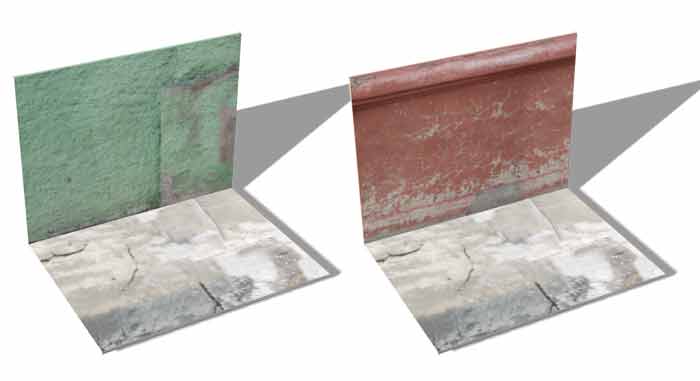 |
|
| WEDNESDAY, DECEMBER 15, 2013 |
| |
| I have been falling back into digital construction, rather than focusing on real installation, as was my plan here in Mexico. I tend to see the digital studio as more efficient, but I need to do some actual installation photography in order to see if this is true or not. If the images collected from real installation are more powerful than those obtained in the digital studio, then there is really no reason to pursue the installation work. |
| So, as soon as I can, I need to get some interesting objects and do some installation work. |
| Yesterday, I constructed 3 digital dioramas using Mexican Found Imagery. |
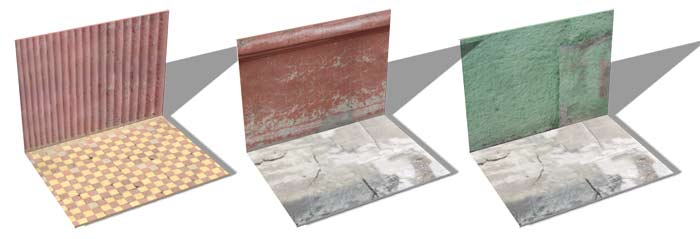 |
| These worked out in practise, but there is one deficiency. They represent too small a section of city. The display area is too small. The diorama platform should be doubled in width and the maps correspondingly doubled in width. It might be easier just to quadruple the size of the maps. Each diorama would appear to be bigger, allowing for more display space. |
| It crossed my mind to refine the basic model, adding a street and curb. But I wonder if this is necessary. Would the entire section actually be used. or is is only this one area that is needed for composition? |
| Note - I need to be thinking of object compositions as much as I can. Yesterday, while building the complete dioramic product, I noted the concepts of enigma, paradox, and startling association as the components in juxtapositional impact. It is not the lovely textural nature of the background that provides the artistic merit of the image, but rather the statement made by the objects populating it. I need to get more objects as symbolic as the warhorn. |
| After breakfast, we scouted some of the markets and shops, looking for potential objects to use in installation. There was a lot of stuff in Puerto Vallarta, but most of it was inappropriate. |
 |
| I ended up finding some stuff in several stores near the Arcos. I may return later today, purchase a few things and try some street installation. One of the items which has a certain attraction is a papier mache doll. |
 |
| 105 pesos. I really don't know if this will work, but I'll think about it for a while. Maybe if the mouth could be changed a bit. |
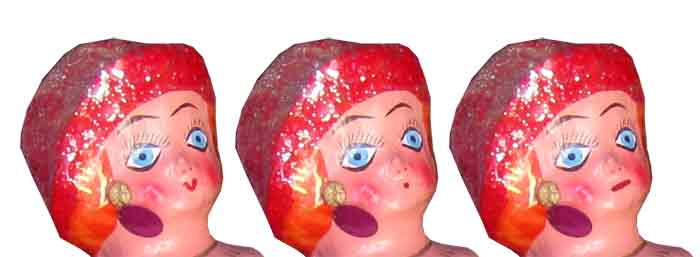 |
The objects which have caught my attention are the following:
1. The large doll (papier mache) - 100
2. Box with panel doors (triptych - Virgin Mary) - 250
3. Ceramic Airplane (people hanging off it) - 100
4. Wooden Airplane (big pink one) - 100
These objects would cost around 600 pesos. But it would be a start. |
| I'm not making very much headway in purchasing the objects I identified. It's getting late enough that if I do purchase them, I'll have to do the actual installation work in Rincon or Los Ayala. |
|
| THURSDAY, DECEMBER 16, 2013 |
| |
| It has been an interesting exercise thinking my way through the method of art construction I currently use. I have certainly been brought into a severe confrontation with the primary aspect of its aesthetic nature. All the components are basically mechanical, except for the actual choice of objects and their arrangement. These two components are the absolute essence of this style. The objects and their arrangement have to bring about a unique juxtapositional impact (there must be a better term for this). In very simple terms, the objecs have to have some tension, they shouldn't belong together, but their associations forces a statement, an interpretation. This is a skillset that needs some practise on my part. I am finding that, more and more, I am coming up empty in this area. This issue applies equally in the digital area as well as the real installment area. |
| As an exercise, let's take the list of objects that I downloaded yesterday and put them in a table. |
| Stairs |
Railway Stuff |
Radiator |
| Train Carriage |
Railway Engine |
Trinket Box |
| Locker |
Toffee Apple |
Boots |
| Rocking Horse |
Camera |
Walnut Box |
| Prayer Wheels |
Diabetic Set |
Horns |
| Bell Jars |
Teddy |
Artillary |
|
| Now, the exercise is to combine some of these objects so that juxtapositional impact results. |
| So, I begin looking through the list to see which ones don't belong together, or speak of opposing experiences. The most obvious is the "Diabetic Set" which consists of a hypodermic needle and a bottle of fluid. Putting this with any of the children's toys brings about an immediate (if not cliched) impact. The other is the artillary cannons and the Prayer Wheels. But these are very obvious associations and have been made many times before. So, there must be almost a hierarchy of impact, from obvious to unique or new. But this is only one type of impact, where the two objects reveal a simple opposition of intent. What would you call this? Contrast? |
| I need to work on the components of Juxtapositional Impact and construct a taxonomy. |
| JUXTAPOSITIONAL IMPACT |
| Contrast |
Two objects share opposing values |
A gun and a bible |
| Enigma |
|
|
| Paradox |
|
|
|
| I should see if I can find some writings about some of the people who use this technique, such as Magritte. |
| Magritte was a master of the obscure. "In his artwork, Magritte toyed with everyday objects, human habits and emotions, placing them in foreign contexts and questioning their familiar meanings. He suggested new interpretations of old things in his deceivingly simple paintings, making the commonplace profound and the rational irrational." Reference |
| Magritte, strove to "rehabilitate the object." To accomplish this goal, an artist would remove an object from its usual context so that its purpose could change. With paintings like La Durée Poignardée (Time Transfixed, 1939), Magritte wanted viewers to put aside utility and common sense while interpreting the objects found in the work. In Time Transfixed, Magritte questions typical perceptions of commonplace objects by painting a miniature train coming out of a fireplace and jutting into mid-air. Unlike the other Surrealists, however, Magritte did not juxtapose unrelated objects to create new definitions. Rather, he believed that all objects are rationally related to other objects. In this way, Magritte explored the relationships between objects in his paintings. The objects painted by Magritte suggest an inherent meaning independent from the viewers' previous experiences, opinions and ideas; as a result, the objects become "concrete universals." Reference |
| "Using perplexing juxtapositions and distortions of commonplace objects and painting in a smooth, illusionistic manner not typically associated with modernist experimentation, Belgian Surrealist René Magritte set out to disturb existing assumptions about rationality and the perception of reality. In The Six Elements, he used his deadpan approach to create a multi-paneled picture within a picture, showing six components--flames, a female torso, a forest, a building facade, clouds in the sky, and a curtain made of lead and sleigh bells--separated by an irregularly shaped painted frame. The title calls to mind the classic formulation of the basic elements of the universe--earth, water, air, and fire--but the links between these and Magritte's set are elusive, presenting teasing riddles for the viewer. Although each element is presented in isolation, the painting, which as two-dimensional as a theater set, calls into question the notion that reality can be divided into separate components and easily subjected to rational analysis. Painted at the end of a three-year stay in Paris, The Six Elements exemplifies the artist's ability to challenge the viewer to search beneath the surface of his flat and enigmatic paintings. Emily Hage, from Masterpieces from the Philadelphia Museum of Art: Impressionism and Modern Art (2007), p. 182. Reference |
| In a sense then, it seems that I should be finding objects that represent or symbolize things I wish to bring attention to. For example, I am interested in topics such as the curbing of speech, supression of expression, forced evangelism. I should be finding objects that represent these and bringing them into the theatrical sets and arranging them so as to make statements. |
| Of course, doing this means that the background set is as important to the object arrangement as the juxtaposition itself. So, the use of the Mexican sets I have been constructing have no use or value. It seems that if I want to make intentional statements, I need to construct all components with the intention in mind. Let's work through some ideas. |
Suppression of Expression - One tool for individual expression is the microphone. I think of the use of radio talk shows as a brilliant form of free speech in our culture. Unfortunately, I see some forms of political action seeking to regulate or actually abolish this. There are some immediate and simple ways to visualize this:
- a microphone in a cage
- a microphone with a gag on it
- a room with standing microphone, all broken off, microphone heads laying on the ground
- a field of microphones (like wheat) with a large thresher mowing them down
- a microphone standing before a firing squad
- a microphone standing with a noose around its neck
These are all very simplistic, however, and don't possess the enigmatic obscurity I enjoy in the viewing process. |
| I am interested in seeing what kind of microphone I recently acquired in my downloads of last night. |
| The microphone was good. Unfortunately, there were no manipulation tools that came with it so it was impossible to scale it. |
|
| FRIDAY, DECEMBER 17, 2013 |
| |
|
| |
| In terms of the "Still Life" I discussed above, I have to modifiy some of my reflections concerning this. A few days ago, I wrotie in my Journal that objects in a visual setting had to act to a certain script. This script defined their existence in terms of Juxtapositional Impact. But I have had time to think about this. I think it is possible to have a simple "Still Life" where the objects simply define a small frozen bit of time out of a selected context. It is this definition I should be carrying around with me here in Mexico, especially here in Los Ayala. |
| I'll start with Bucerias Photos - Tequila - IMG_1240.jpg. I think I'll start this one as back05.jpg and keep a running Poser diorama going to test each of them. |
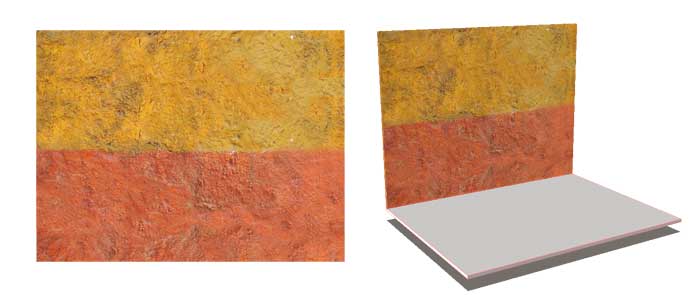 |
| back05.jpg is a large file - 8000 x 4000 px. Twice as large (actually 4x) as I'm used to making. |
| Worked on another image from Tequila - street05. |
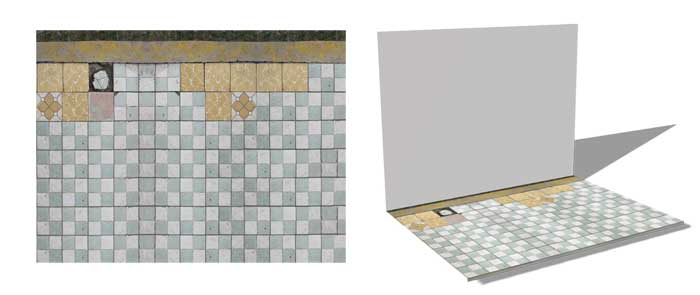 |
| Conclusion - I didn't really return to any photography at this point. I confined myself to working inside the digital 3D Studio for the rest of the journey. I focused on the Mavka Painting, which used the ideas above, but worked through them in Poser (3D software) and Photoshop. |
|
| |
|
| PRODUCTION - URBAN ART - By Don Bergland |
|
|
| You can explore further Studio Production Instructional Details through Don Bergland's Online Journal |
|
|
|

